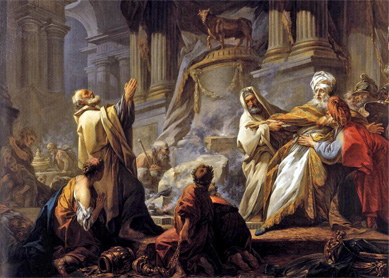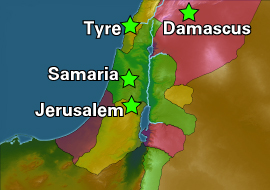Between Gen 29:1-30:43 and Gen 35:16-18, the patriarch Jacob becomes the father of twelve sons: Reuben, Simeon, Levi, Judah, Dan, Naphtali, Gad, Asher, Issachar, Zebulun, Joseph, and Benjamin. By the end of Genesis, these twelve sons have become the eponymous ancestors of the twelve tribes of Israel. From that point on, the twelve tribes of Israel are the main protagonists of the Bible’s visions of history. These tribes are the ones that Moses leads out of Egypt, that wander through the wilderness together, that conquer Canaan with Joshua, and that, ultimately, divide the promised land between them. They are the ones that are ruled, if fitfully, by the titular figures of the book of Judges and then by Saul, David, and Solomon during Israel’s United Monarchy. In 1Kgs 11:1-12:33, the kingdom of Israel splits into two, Israel and Judah, never really to be united. In 2Kgs 17, Israel, and not Judah, is conquered by the Assyrians, with the apparent loss of many of the tribes into exile. Still, the twelve tribes of Israel remain at the center of the biblical account, not just of Israel’s history, but of who “Israel” fundamentally is.
History or Myth?
How scholars think about the twelve tribes of Israel, both as a historical institution and as a tradition, has changed as scholars have reconsidered the reliability and antiquity of biblical traditions more generally. Over the course of the last century or so, scholars have broadly given up on the historicity of almost every era in which the tribal organization is supposed to have been the dominant political structure: the exodus, the wilderness wanderings, and the conquest of Canaan. Since the 1930s, many scholars have argued that there were twelve tribes of Israel, but that they formed only in Canaan and only in the few centuries before the rise of monarchy in Israel, not in Israel’s more remote prehistory. These reconstructions, even of the premonarchical period, are often very different from anything the Bible describes, but they do affirm both the antiquity and the basic reliability of the twelve tribes tradition to some degree.
More recently, however, even these comparatively modest arguments have faced serious challenges from those who wonder whether the “all Israel” identity embodied in the tribal concept ever actually existed in early periods. Increasingly, scholars realize it is possible that Israel and Judah were never actually unified, and some have argued that the belief that they were developed only in Judah, sometime after the Assyrian conquest. Others merely point out that the available evidence does not support the existence of so powerful or so organized an entity as the biblical twelve tribes of Israel in early periods and argue instead for something smaller and looser—whether it included the ancestors of both Israelites and Judahites or not. Either away, while scholars still generally believe that early Israel was a tribal society, many now wonder whether the biblical account of the twelve tribes represents an idealized or even invented vision of early Israelite realities, emerging only in relatively late periods.
An Israelite idea or a Judahite idea?
Today, scholars are increasingly reassessing the importance of certain facts about the composition of biblical tribal traditions that have long been acknowledged but rarely appreciated. In short, not only were the main biblical accounts of the Israelite past generally shaped in Judah after the fall of Israel, the vast majority of descriptions of the tribes of Israel must be included in this category. On the one hand, there are still descriptions of tribal Israel that scholars believe to be very early, including Gen 49 (the so-called “Blessing of Jacob”), Deut 33 (the “Song of Moses”), and Judg 5 (the “Song of Deborah”). The continuities between these texts and the rather voluminous corpus of later, Judahite traditions reveals the deep antiquity of some aspects of the twelve tribes concept and, likely, of tribal realities.
On the other hand, these continuities are neither so significant nor so prevalent that they are really capable of demonstrating the early existence of the familiar twelve tribes tradition itself or the institution to which they refer. In fact, the opposite case seems increasingly easy to make. For one thing, of the three aforementioned lists, only Gen 49 even mentions twelve tribes. For another, the tribes of Judah, Simeon, and Levi are the ones most often regarded as the tribes of the kingdom of Judah—though some have argued that Benjamin should be included in this group—and Judg 5, generally considered to be the oldest tribal text in biblical literature, does not include any of them. Deut 33 is also missing Simeon, and long before the historicity of the twelve tribes concept was seriously challenged, some had argued that Levi and Judah might have been added to the original text and that the blessings of all of Judah, Levi, and Simeon in Gen 49 may have been part of another poem originally. Meanwhile, outside of the Bible, there are virtually no references to the tribes—individually or as a whole—in the historical record save perhaps for a reference to Gad in the Mesha Stele, a Moabite inscription from the ninth century BCE. Still, scholars are careful about what conclusions they draw about the ancient world from poor or absent evidence, and they will no doubt continue debating the origins of the twelve tribe concept for quite some time.
Bibliography
- Knauf, E.A., and Philippe Guillaume. A History of Biblical Israel: The Fate of the Tribes and Kingdoms from Merneptah to Bar Kochba. Sheffield: Equinox, 2016.
- Fleming, Daniel E. The Legacy of Israel in Judah’s Bible: History, Politics, and the Reinscribing of Tradition. Cambridge, Engl.: Cambridge University Press, 2012.
- Crouch, Carly. The Making of Israel: Cultural Diversity in the Southern Levant and the Formation of Ethnic Identity in Deuteronomy. Leiden: Brill, 2014.





